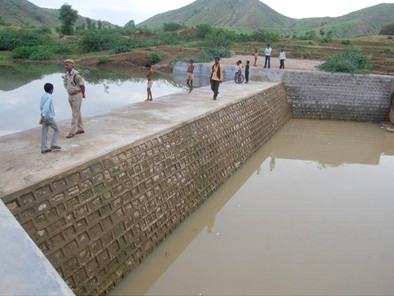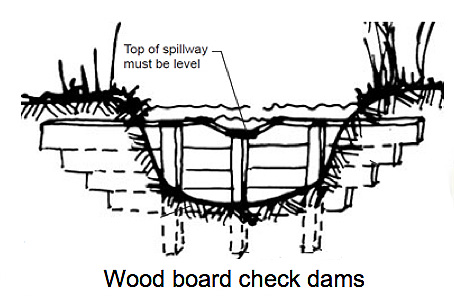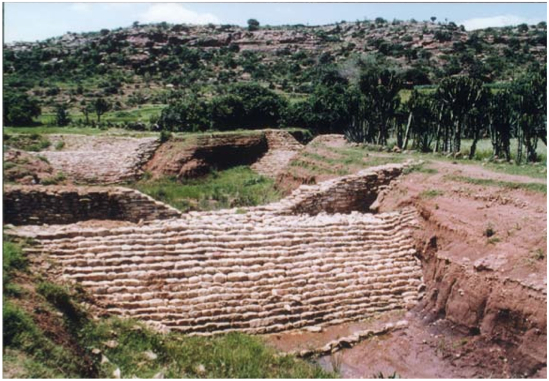वाटर पोर्टल / वर्षाजल संचयन / भूजल पुनर्भरण / चेकडैम (गली प्लग)
< वाटर पोर्टल / वर्षाजल संचयन | भूजल पुनर्भरण| |
|
|
|
|
|
|
|
|

चेकडैम छोटा, अस्थायी या स्थायी बांध है, जिसका निर्माण एक जल निकासी खाई, गली, स्वेल या चैनल के आसपास किया जा सकता है ताकि तूफान आने पर संघनित प्रवाह की गति को कम किया जा सके. वे बाढ़ के पानी के एक प्रकार के रूप में वर्गीकृत किये जा सकते हैं, बनिस्पत एक अपवाह संचयन तकनीक के. चेकडैम लकड़ी, पत्थर, मटर बजरी से भरे मिट्टी के बैग या ईंटों और सीमेंट से बनाया जा सकता है. इनका केन्या और भारत में व्यापक रूप से इस्तेमाल किया गया है. इन बांधों भी रिसाव बांधों के रूप में बनाया जा सकता है. ऐसे डैम जो नदी के बेड पर मोटे रेत परिवहन (रेत बांधों) से बनाये जाते हैं, उपयोग होते-होते खत्म हो जाते हैं. ये संरचनाएं अपेक्षाकृत सस्ती होती हैं और 2-5 साल तक चलती हैं.
Contents
उपयुक्त परिस्थितियां
- प्राकृतिक अपवाह क्षेत्रों में लगाएँ.
- आसपास के क्षेत्र की मिट्टी में पर्याप्त रिसाव क्षमता जरूरी है.
| लाभ | हानि |
|---|---|
| - - पानी की गति धीमी हो जाती है, जो कटाव को कम कर देती है और बाढ़ के दौरान अवांछित गली निर्माण से बचाती है. - खाई डिजाइन आवश्यक नहीं है, सिर्फ मौजूदा गली जल निकासी पैटर्न का उपयोग करता है. |
- अगर गलत तरीके से डिजाइन किया गया हो, तो मछलियां इस पार से उस पार नहीं हो पातीं. - इसमें गाद भर सकता है और रखरखाव की आवश्यकता हो सकती है. |
Resilience to changes in the environment
Drought
Effects of drought: Lower crop yields.
Underlying causes of effects: Less water to crops.
To increase resiliency of WASH system: Drought-resistant & fast-growing crops; Diversify livelihoods of farmers.
More information on managing drought: Resilient WASH systems in drought-prone areas.
Floods
With intense rain events, see if the check dam is still managing flow from its center. If it is not, the dam could crumble, rendering it ineffective, and will need rebuilding.
Construction, operations and maintenance
General advice on cement: A common cause of cracks in structures and linings (e.g. in tanks, dams, waterways, wells) is errors in mixing and applying the cement. First of all, it is important that only pure ingredients are used: clean water, clean sand, clean rocks. The materials have to be mixed very thoroughly. Secondly, the amount of water during mixing needs to minimal: the concrete or cement needs to be just workable, on the dry side even, and not fluid. Thirdly, it is essential that during curing the cement or concrete is kept moist at all times, for at least a week. Structures should be covered with plastic, large leaves or other materials during the curing period, and kept wet regularly.
Specific advice:


Drawing: Water Conservation Technical Briefs. SAI.
The sides of the check dam must be higher than the centre so that water is always directed over the centre of the dam (this avoids the dam being outflanked by the flow).
The dams can be made of temporary or permanent materials in natural gullies in the land surface. Materials used are concrete, earth, vegetation, stone and brushwood. Where earth is used, erosion or destruction of the structure needs to be avoided – to do this, a concrete spillway is often constructed. As they use the existing drainage system, no design of trench is needed (as with contour trenches).
Do not construct check dams in watercourses or permanently flowing streams without specific design (because of possible restrictions to fish passage).
Water extraction
- Water that infiltrates is used as soil moisture for crops cultivated after a rainfall event.
- Water can be used directly for pumped irrigation.
- Water can be taken from shallow wells and boreholes in the immediate area.
Maintenance
Check dams should be inspected regularly for sediment accumulation after each significant rainfall. Sediment should be removed when it reaches one-half of the original height or before. Check to ensure that the flow is over the centre of the dam and not either under or around the dam. Check that there is no erosion at the outfall.
Costs
The cost in India is reported to be between US$200-400 for temporary dams (made from brush wood, rocks, soil) and US$1,000- 3,000 for permanent dams (made from stones, bricks, cement), depending on the length and height. Variation depends on materials used and size of gully.
Field experiences
In Ethiopia, unclarity over land tenure led to progressive abandonment of cropping in gullies. See: Falkenmark, M.; Fox, P.; Persson, G.; Rockström, J. (2001) Water harvesting for upgrading of rainfed agriculture. Problem analysis and research needs. Stockholm International Water Institute.
Manuals, videos, and links
Acknowledgements
- CARE Nederland, Desk Study: Resilient WASH systems in drought-prone areas. October 2010.
- Rufino, L., Water Conservation Technical Briefs: TB 2 – Rainwater Harvesting and Artificial Recharge to Groundwater. Sustainable Agriculture Initiative (SAI). August 2009.
